By the late 1970s, Disney had proven that it could continue financially without Walt Disney. Both Disneyland and Magic Kingdom were thriving, with Walt Disney World busily building its third park, Epcot (then referred to in large capital letters as EPCOT). The Rescuers had been a hit. Re-releases of previous Disney animated films had proven popular, allowing even the financial failures to move into the black, and the firm was, as always, doing well with merchandise sales.
And, after a four year gap, executives decided it was time to give another nod to the artform that had started this all. Not with anything too innovative, of course, even if innovative animation had been part of Disney since the beginning. No, nothing that would challenge the Disney brand, at least, not until this new group of animators, largely working outside the supervision of the Nine Old Men (the original Disney animators who had worked on the classic films) had proven themselves with a safe film. No, nothing too different. Another animal film, perhaps. Featuring cute little animals, with feel good, family friendly themes of friendship and growing up.
Why precisely anyone thought the anti-hunting, anti-suburbia, lots of puppy killing The Fox and the Hound novel was the best way to accomplish this remains a mystery. Then again, Disney already had a grand tradition of greatly deviating from the source material. With both Sleeping Beauty and The Jungle Book as successful, Walt-guided examples, the animators decided to do just that here, jettisoning virtually everything in the original book except for the bit where two of the main characters are a fox named Tod and a hound named Copper.
In one of the few nods to the original work, the The Fox and the Hound starts off on an appropriately haunting note, in a forest clogged with clouds and fog, and an endless wind, in contrast to the usual cheerful opening music employed in most Disney flicks. It’s the setup for a hunting scene, one of several cribbed from Bambi, although for the actual animal movements, Disney animators relied on recent Disney nature documentaries. Like the Bambi scene, this one ends with a gunshot, leaving a little red fox cub quivering by a fence, and viewers not left in much doubt about what just happened (though compared to the graphic stuff in the book, this is nothing.)
Fortunately, the fox is found by Big Mama, an owl voiced by the incomparable Pearl Bailey, whose singing is one of the highlights of the film—even if the songs themselves aren’t much. It’s not exactly clear why an owl would want to help out a fox, even if Big Mama is, well, the motherly sort, and it’s another strong deviation from the source material, where the fox never receives help from other species, but here, not only does this provide immediate assistance for Tod, but it allows the film, through Big Mama, to summon the film’s comedy relief: Dinky, a sparrow, and Boomer, a woodpecker. Those two attract the attention of the widow Tweed, a human, who takes one look at Tod and falls absolutely in love with the adorable little fox.
I said adorable, not good. Tod always means well, but his natural curiosity, friendliness and complete inability to listen to either well-meant advice or outright commands continually get him and everyone around him into major trouble. This is particularly true when he meets the not overly bright puppy next door, Copper, and decides to be friends.
Copper and Tod have a wonderful time together—playing hide and seek, swimming, exploring—and Tod happily announces that Copper is his best friend, despite multiple warnings from the other animals, notably Mama Owl, but also including Copper, that this might not go well, given that Copper’s destiny is to be trained as a hunting dog, and more specifically, a dog that hunts foxes. Tod doesn’t care, firm in the innocent puppy belief that Copper will always be his best friend. The not all that bright Copper, agrees. Even after a rather disastrous encounter with Amos Slade, Copper’s owner, Tod still remains confident that he and Copper will always be best friends—to the point where he sneaks out to wave goodbye to Copper as Slade takes the puppy away to be trained as a hunting dog.
Which means, when Copper returns, he is a hunting dog, trained to kill foxes. Tod has missed his friend too much to care, heading over anyway, setting off a chase sequence that leads to the major injury of Slade’s other dog, Chief. Copper and Slade both vow revenge, and the Widow Tweed hastily removes Tod off to a nearby no hunting allowed preserve. Naturally it rains. And equally naturally, Copper and Slade follow Tod there—and encounter something far worse for them than an illicit relationship between a fox and a hound: a really angry bear.
During all this, every once in a while the film makes a nod to the original book. Chief, for instance, gets hit by a train while chasing Tod, echoing a similar scene in the book, although, since the film is considerably cheerier, in this version, Chief lives. Tod, as in the book, springs traps without getting caught by them—a major book plot point. In both, Copper is devoted to a master who probably doesn’t deserve it. Even more in this film, where Slade is an outright villain who ties a little puppy up just because the puppy wanted to play (sniffle—find me a five year old who can’t sympathize with that, and I’ll show you a space alien pretending to be a five year old) and whose later attempts to kill Tod end up nearly killing several other characters, and causing extensive damage. And both, of course, focus on hunting, with the film even adding a second hunting subplot with two birds and a caterpillar, played partly as a mirror of the main hunting plot and mostly for comic relief.
Some elements appear in reverse: here, for instance, Chief is jealous of Copper, instead of the other way around. And although the bear encounter is more or less taken from the book, here it appears in a completely different place, involves fewer dogs and people, and the fox, not a dog, is the one to take down the bear. That change lets the film continue to play with audience expectations: not only is the fox friendlier and more loyal than the dog, but also braver.
But otherwise, as with Sleeping Beauty (hi, dragon!) and The Jungle Book, The Fox and the Hound largely abandons the source material, and in particular, its realism. I can’t imagine, for instance, what Mannix would have had to say about a caterpillar that managed to stay in caterpillar form for what seems to be about a year, let alone the idea of a fox willingly attacking an angry black bear to save a dog, or the idea of a fox willingly staying inside a human home for more than a few months. And although the film does touch on hunting, its focus is on something entirely different: not the evils of hunting, but the evils of letting society, rules, and preconceived concepts guide our decisions.
Tod may be wrong about the strength of his friendship with Copper, someone technically on the other side. After all, Copper’s “I don’t want to kill you” is not exactly the strongest expression of friendly support I’ve heard, and the dog doesn’t hesitate to vow vengeance on the fox. But in the end, the film agrees with Tod’s steadfast belief that he and Copper could be friends. The only reason they aren’t is that everyone thinks that hunting dogs and foxes can’t be friends, and Slade has decided to turn Copper into a hunting dog. Copper, eager to please Slade, goes along with this. Until, that is, Tod saves Copper’s life, changing the dog’s mind, and proving that yes, anyone can be friend, no matter what society—or in this case, biology—might say.
It’s not the most original message, let alone the most original of Disney films. But it is comforting film, assuring us that yes, friendships—real friendships—can survive anything. Even grownups trying to keep us apart. Even tragedies. Even bears. Tod and Copper may never quite go back to their childhood antics. They aren’t, after all, puppies anymore. Tod now lives in the forest, and Copper is still a hunting dog, even if the last couple of minutes of the film suggest that his owner might not be doing as much hunting in the future. The film’s last moments, showing Tod and Copper at a distance, allow that friendship to be mixed with a touch of biological reality. While also, I must admit, not doing all that much for the film’s not always particularly subtle message that people who look different can still be friends, but let’s try to focus on the comfort for now.
That comfort was enough to let The Fox and the Hound do well, if not spectacularly, in its initial box office release. Subsequent re-releases and DVD sales performed well enough to justify a 2006 direct-to-video sequel, The Fox and the Hound II. But the long term impact of the film turned out to be not so much on Disney, but on the animators involved in the film in two profound ways.
First, thanks to a remarkable coincidence, The Fox and the Hound just happened to enter production just as the California Institute of the Arts just happened to be graduating a rather remarkable group of students who were immediately hired by Disney to work on this film. They included, among others, Brad Bird (who would later be known for a tiny little film called The Incredibles, as well as a film about a rat with a cooking obsession), Tim Burton (who would later work on The Nightmare Before Christmas, James and the Giant Peach, and Frankenweenie), and John Lasseter (who had ideas about toys).
Perhaps surprisingly, given their later work, all three had initially problems fitting in with the studio. Brad Bird remained only briefly, choosing to head off to television animation; Tim Burton was, well, Tim Burton; and shortly after the 1981 release of the The Fox and the Hound, someone showed John Lasseter a computer, triggering both what would become his personal obsession and a tug of war between him and Disney that would not be completely settled until 2006. Still, for all three, The Fox and the Hound marked the start of decades of work with Disney animation.
The second way turned out to be considerably less positive for the company: animator Don Bluth, who had worked on Robin Hood and The Rescuers, quit in the middle of production to form his own animation studio, Don Bluth Productions. Bluth would later work with Steven Spielberg and Fox Animation to produce an assortment of films, from flat out terrible films (Thumbelina—avoid, avoid, avoid) to crowd-pleasers (An American Tail, The Land Before Time, and Anastasia) that temporarily established Bluth as Disney’s main competitor for animated films. That is, until John Lasseter decided to go public with his computer obsession.
In the meantime, Bluth’s abrupt departure was a troubling sign, exposing a deep schism in the animation studio just as it was gearing up to make its most ambitious film since at least Sleeping Beauty and possibly even Pinocchio or Fantasia. The Black Cauldron, coming up next—with a post about the film, since I previously blogged about the book for Tor.com here.
Mari Ness lives in central Florida.










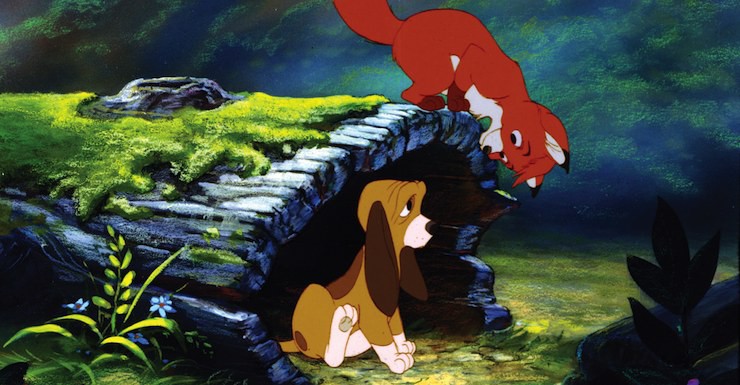
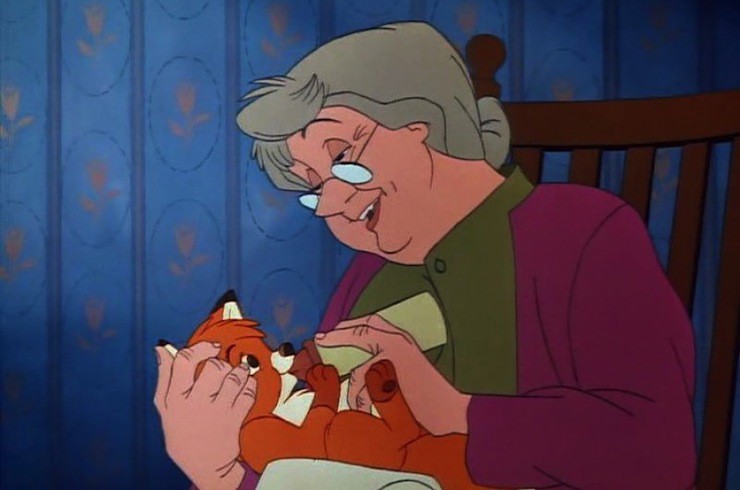
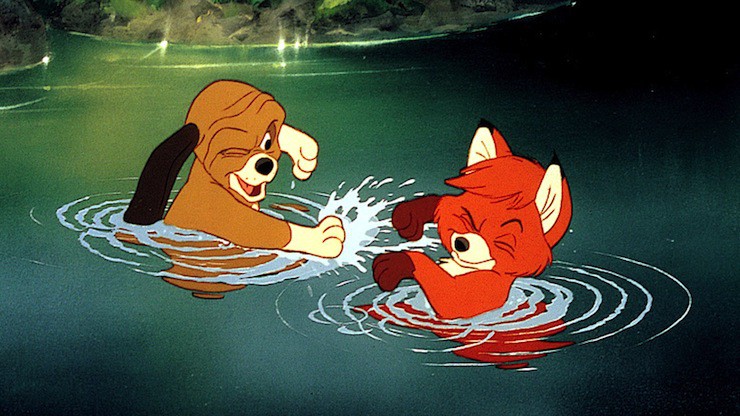
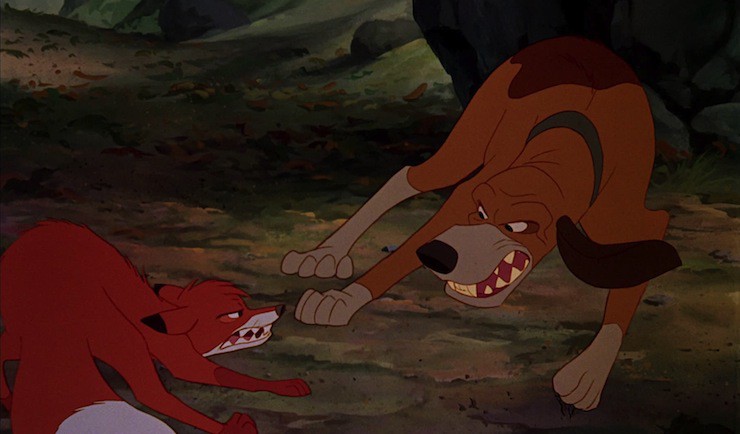
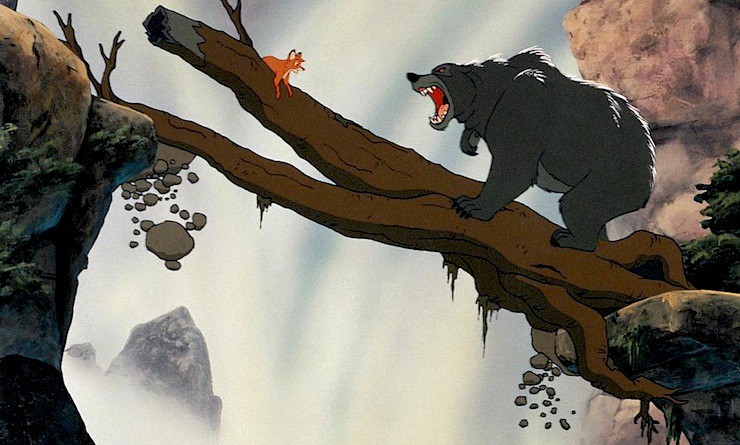
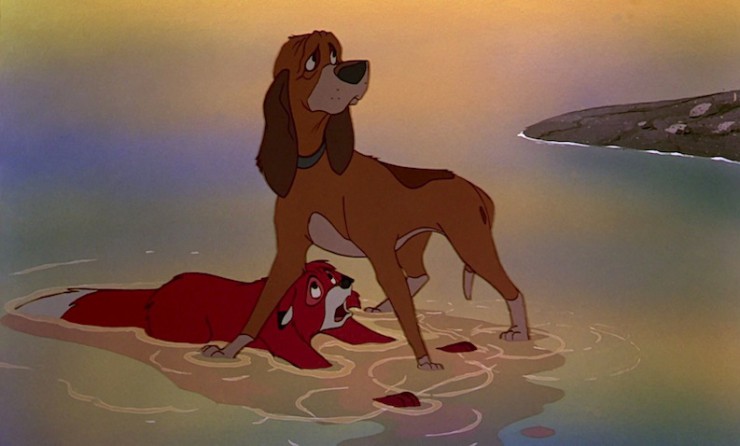
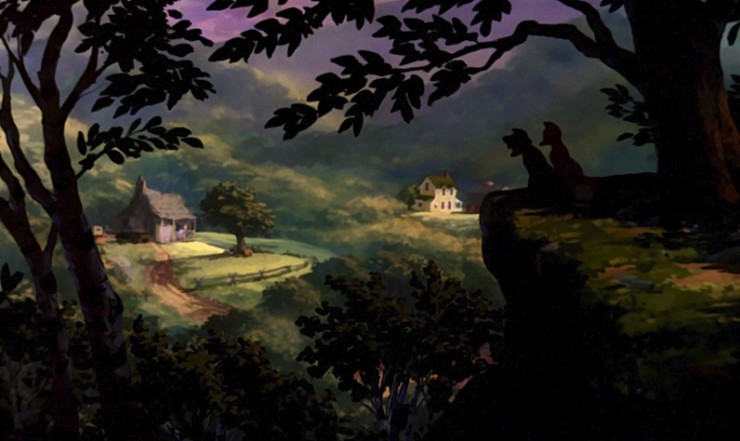
You should really link to your Book of Three post as well, since the movie was based on that at least as much as The Black Cauldron.
I am a little surprised this movie did as well, as it’s probably one of my least favorite Disney movies. Perhaps part of it is that it doesn’t have the musical aspect I tend to enjoy in a lot of my favorite Disney films (I honestly can’t remember a single song from this movie) and I hated that whole caterpillar bit. But I also wonder how much of this movie (or the way it was regarded) was influenced by the civil rights movement; aside from the fact that of course there is a lot more of a difference between a dog and a fox than people of different races.
Quite interesting about the new animators though, I hadn’t known that they all started there at the same time!
There was a very interesting documentary about Walt Disney on PBS’s American Experience a few weeks ago. It goes beyond the movies, of course, with Disneyland etc, and ends with his death, but it’s well worth watching. One of the things that piqued my interest was one of the interviewees — I can’t remember who — talked about the first five Disney films (Snow White, Pinocchio, Fantasia, Dumbo and Bambi) being known as “the big 5” and how different their animation styles were from each other and from all the other films after them, being made before the “Disney style” of animation was developed. I haven’t been able to find anything else about this concept, but it would be interesting to explore.
A side anecdote about those new animators (sort of). My parents have a very good friend from college who became a TV screenwriter. Early in his career, he worked at Disney with Tim Burton. According to my parents, their friend gave us a tour of his offices (which I don’t remember because I was very young), and showed us Burton’s workspace, which was completely covered in little figures he had made of characters from his imagination. My parents commented on them and their friend said something like “oh yeah, this guy’s amazing, but he’s completely crazy.”
I remember reading an article? interview? many years ago that said that they had to drop The Fox and the Hound into the animation schedule in front of Black Cauldron because the animation department had atrophied to the point where they were afraid it wouldn’t be able to handle what they thought of as a big animated fantasy epic; so they wanted something smaller-scale as a warm-up.
I know I saw this in its original theatrical run, and I was definitely old enough to remember it (a preteen), but while I remember seeing the movie, I remember no details about it. I don’t think it made much of an impression on me. I don’t think I’ve even watched it since then. It’s not one that pops up on the Disney channel, or if it does, it doesn’t hit my “hey, I liked that, I should watch it” button. I’d forgotten about Pearl Bailey being involved until reading this article.
Lisamarie – It’s definitely not one of the more memorable Disney films. My guess is that the lack of competition and even other recent films helped it at the box office.
Brightbetween – I’m not entirely sure what’s meant there by a Disney “style” of animation – most of the Disney films tend to have very different looks up until One Hundred and One Dalmatians; afterwards, xerography gave the next films a similar look up until The Great Mouse Detective and The Little Mermaid. But those first five films, except for Dumbo, did have a much bigger budget than any other animated film until Sleeping Beauty, and then until The Black Cauldron, and their animators had significantly more freedom to invent and do multiple things both with the animation and the camera. There’s definitely a distinction in quality between Pinocchio and Fantasia on the one hand, and The Jungle Book on the other.
Hoopmanjh – The animation department just didn’t have many animators, period, and it seems very possible that they were hoping to create the next Star Wars for Disney animation. We’ll be looking into the disaster that resulted in the next post.
Shanna Swendson – It is sad when you can’t remember a Pearl Bailey performance of any kind, but, yeah, nothing in this film is all that memorable.
I’m partial to this one. Always been a sucker for friendships with villains, and “friends who didn’t know they were enemies” sufficed in this case, even if neither were the villains. Also, cute animals and beautiful scenery.
I never liked the bit where Big Mama tells herself “You oughta lose a few pounds.” Not because it’s a fat joke, but because she’s an owl. The largest owl species common in North America, the Great Horned Owl, only weighs 5.5 pounds at most. Get your biology reasonably right, people.
Clever to have Tod named for being “such a toddler,” explaining the name to kids unfamiliar with “Tod” as the British nickname for foxes.
Boomer was voiced by the same person as Tigger, wasn’t he? And didn’t the porcupine share a voice actor with Piglet?
I’m truly astonished that this isn’t a more popular film, and is seen as “not really memorable”. It’s one of my absolute favourites, and I sincerely thought that it was universally a favourite – I had no idea my opinion was unusual. I remember seeing it when I was young and it made a lasting impression on me. The forbidden friendship absolutely gripped my young heart. The bear was truly terrifying. The violence of the other dog being hurt, and of the betrayal of the friendship, earth-shattering. The caterpillar bit was *hilarious*. And of course I adore owls, and Big Mama just made you want to cuddle up with her with some hot cocoa and a blanket and watch a fire.
And then when Copper stands up for Tod…The second last photo in this article. The body language is exquisite. The subtle, quiet motion he makes to stand over him even more securely. He’s terrified, but he’s standing his ground. The *silence* around the scene, no distractions, just the pure emotional event in front of you. Even as an adult, I’m brought to tears just looking at the photo. It’s one of the most powerful scenes, for me, from any children’s movie.
This is one of the handful of Disney animated features I haven’t actually seen…and this review makes me think that I probably ought to see it, warts and all. Very thoughtful treatment here.
Considering the focus of this read-watch, however, I am surprised that your bio-sketch on Brad Bird doesn’t mention his first animated feature, The Iron Giant, which is based on a book of that title…but which bears about as much resemblance to that book as the Disney version of The Fox and the Hound does to its source canon.
In German this is called Cap and Capper.
AeronaGreenjoy – Yes, Paul Winchell voiced both Tigger and Boomer. John Fiedler, who voiced the porcupine and Piglet, was one of those Hollywood character actors who made brief appearances in all kinds of things; apart from Piglet, my guess would be that most people knew him from a recurring guest role on The Bob Newhart Show. Both he and Newhart were also in The Rescuers.
John Bunnell – I was mostly trying to focus on what those three had done with/for Disney, which for Brad Bird is really The Incredibles and Ratatouille (and I guess Tomorrowlland, although that’s not really animation.) In the case of Lasseter I had to immediately give up since that could and has easily filled a book, and he’ll be coming up in a number of future posts.
@8 – Although I am really not a fan of this movie (granted, I didn’t see it until later in life) I can totally empathize with you in general, because I happen to love Robin Hood, The Black Cauldron (kind of excited for that discussion, actually) and a few others that are generally seen as ‘bad’ Disney movies. So I think it’s lovely that you have such fond/personal associations with it :)
To say nothing of the upcoming Little Mermaid and Beauty and the Beast (which of course are not ‘bad’ Disney movies by any means) which have super problematic aspects but I probably will never be able to not love ;)
The story-line of the movie reminds me of the Kipling episodic novel, Thy Servant a Dog. Two Aberdeen terriers (Scotties) make friends with the hound pup next door. The hound, eventually part of a fox-hunting pack, and a local fox are acquaintances, and eventually, after they are both injured, set up a play hunt for the boy who owns the terriers.
Aerona – Your biggest problem with the owl was that she thought she was heavy, not that she was always out in the daytime? The owl in Bambi was awake in the daytime as well, but it was clear that he never really wanted to be. Big Mama, on the other hand, doesn’t seem to be nocturnal at all.
VoVat, there are a few diurnal owl species, including Snowy Owls and the Northern Hawk Owl.
Childhood memories.